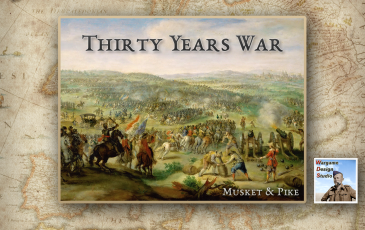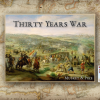014_Wimpfen - Variant - WDS Thirty Years War

435be480296def0cb8f9.jpg) 0 - 0 - 0
0 - 0 - 0
64f8a9520a0c004fd5ef.jpg)
| Rating: | 0 (0) |
| Games Played: | 0 |
| SM: | 2 |
| Turns: | 25 |
| Type: | Stock |
| First Side: | Imperialist (TYW) |
| Second Side: | Anti-Imperialist (TYW) |
Date: 6th May 1622 - Size: Medium - Location: Wimpfen, Swabian Circle, HRH, now Baden Württemberg
Scenario Briefing: The Battle of Wimpfen: Shorter version - After the decisive victory at White Mountain in 1620 it was erroneously assumed by the Imperialist leaders that peace could be restored. However, the Anti-Imperialist leader, Frederick of the Palatinate, refused to admit defeat and his general, Mansfeld, was able to raise fresh forces. An additional Anti-Imperialist army was raised by Duke Christian of Brunswick, so Tilly and his Spanish allies were compelled to deal with these threats. On 27th April, Tilly had suffered significant losses at Mingolsheim when attempting to prevent Mansfeld and another Anti-Imperialist army under Baden joining forces. The combined Anti-Imperialist armies numbered between 25,000 and 30,000 and the Catholics - even after Tilly had been reinforced by Cordoba's Spanish - were only 18,000 strong, so Tilly took up a defensive position at Wimpfen. Instead of attacking the outnumbered Catholics, Mansfeld - who had taken a strong dislike to his ally Baden - decided to march off to the Spanish outpost at Ladenburg in the hope of inducing Cordoba to rush off to defend it! This left Baden, who was now outnumbered 3:2, to face the Catholic forces by himself. Baden was confident that his wagon laager (a line of battle wagons), defended by guns and musketeers, would be strong enough to repel any Catholic assault, but he also had a main line of infantry behind and a powerful force of cavalry to launch a counter-attack.
After several hours of skirmishing and an artillery duel which favored the Catholics occupying higher ground, Tilly launched an initial, but unsuccessful, infantry attack on the Anti-Imperialist defenses around 11am. Then, after dealing with Spanish skirmishers in the woods that were threatening to outflank his position, Baden launched a powerful cavalry counter-attack against the enemy flank. This charge threw the Catholics into disarray and, if the Anti-Imperialist infantry had supported the attack, might have secured victory. However, once Baden's charge had spent itself, Tilly's cavalry gradually forced the exhausted Anti-Imperialist horse back until they routed, while the Catholic infantry made another assault on the wagon laager. At this point, one of the Anti-Imperialist powder wagons blew up, blasting a hole in the defenses. Most of the Anti-Imperialist foot now broke and melted away. Although some 2/3rds of Baden's army escaped the battlefield, Mansfeld was only able to salvage around 3,000 men, with the remainder so demoralized by the defeat that they quickly deserted.
This version uses the long version of the Anti-Imperialist line, also found in the "e" variant.
Recommended Rules: Default
Note: Best played as the Catholic (Imperialist) side against the Anti-Imperialist A/I or else Head-to-Head. Note: This map is orientated with the top of the map facing East and North facing the left map edge.
Scenario Briefing: The Battle of Wimpfen: Shorter version - After the decisive victory at White Mountain in 1620 it was erroneously assumed by the Imperialist leaders that peace could be restored. However, the Anti-Imperialist leader, Frederick of the Palatinate, refused to admit defeat and his general, Mansfeld, was able to raise fresh forces. An additional Anti-Imperialist army was raised by Duke Christian of Brunswick, so Tilly and his Spanish allies were compelled to deal with these threats. On 27th April, Tilly had suffered significant losses at Mingolsheim when attempting to prevent Mansfeld and another Anti-Imperialist army under Baden joining forces. The combined Anti-Imperialist armies numbered between 25,000 and 30,000 and the Catholics - even after Tilly had been reinforced by Cordoba's Spanish - were only 18,000 strong, so Tilly took up a defensive position at Wimpfen. Instead of attacking the outnumbered Catholics, Mansfeld - who had taken a strong dislike to his ally Baden - decided to march off to the Spanish outpost at Ladenburg in the hope of inducing Cordoba to rush off to defend it! This left Baden, who was now outnumbered 3:2, to face the Catholic forces by himself. Baden was confident that his wagon laager (a line of battle wagons), defended by guns and musketeers, would be strong enough to repel any Catholic assault, but he also had a main line of infantry behind and a powerful force of cavalry to launch a counter-attack.
After several hours of skirmishing and an artillery duel which favored the Catholics occupying higher ground, Tilly launched an initial, but unsuccessful, infantry attack on the Anti-Imperialist defenses around 11am. Then, after dealing with Spanish skirmishers in the woods that were threatening to outflank his position, Baden launched a powerful cavalry counter-attack against the enemy flank. This charge threw the Catholics into disarray and, if the Anti-Imperialist infantry had supported the attack, might have secured victory. However, once Baden's charge had spent itself, Tilly's cavalry gradually forced the exhausted Anti-Imperialist horse back until they routed, while the Catholic infantry made another assault on the wagon laager. At this point, one of the Anti-Imperialist powder wagons blew up, blasting a hole in the defenses. Most of the Anti-Imperialist foot now broke and melted away. Although some 2/3rds of Baden's army escaped the battlefield, Mansfeld was only able to salvage around 3,000 men, with the remainder so demoralized by the defeat that they quickly deserted.
This version uses the long version of the Anti-Imperialist line, also found in the "e" variant.
Recommended Rules: Default
Note: Best played as the Catholic (Imperialist) side against the Anti-Imperialist A/I or else Head-to-Head. Note: This map is orientated with the top of the map facing East and North facing the left map edge.





















